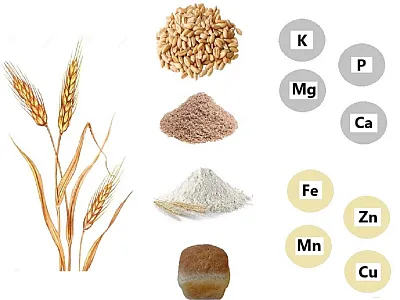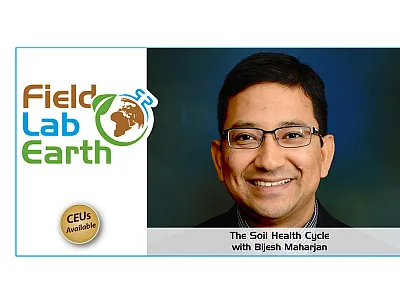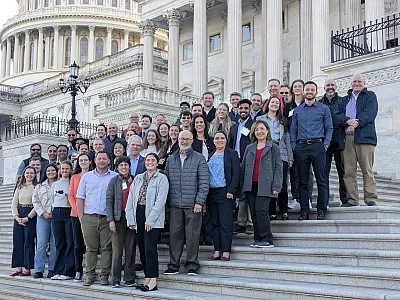Blending biosolids with mulch to reduce PFAS contamination

- Packed with nutrients and organic matter, biosolids have been shown to aid plant growth and boost soil quality. As part of the biosolids production process, the sludge that comes out of sewage plants is treated to remove hazardous toxins like pathogens and metals. But those processes don’t remove everything, like per- and polyfluoroalkyl substances (PFAS), for instance.
- This month, we’ll look at two new studies probing how reused waste contributes to PFAS exposure in the environment, both published as part of the new Journal of Environmental Quality (JEQ) special section, “PFAS in Agroecosytems: Sources, Impacts, and Opportunities for Mitigating Risks to Human and Ecological Health.”
- In this article, researchers tested how biosolids applied to rejuvenate poor quality soils affected PFAS concentrations in soil leachate. The authors also evaluated a potentially low-cost, low-effort solution to mitigate PFAS concentrations—blending biosolids with wood mulch.
“We’ve been doing it since the beginning of time,” says Linda Lee, a researcher at Purdue University. Lee is referring to the age-old practice of spreading poop on land to fertilize crops.
"Biosolids recycle waste into nutrient-rich soil amendments, but they can also introduce PFAS, ‘forever chemicals’ that persist in the environment. New research explores how biosolid application affects PFAS movement in soil and a potential solution—blending with wood mulch—to mitigate risks."
Today, that process has been extensively researched, refined, and regulated, and treated solid sewage, known as “biosolids,” is boosted by advocates as a hugely beneficial way to recycle waste. Packed with nutrients and organic matter, biosolids have been shown to aid plant growth and boost soil quality.
As part of the biosolids production process, the sludge that comes out of sewage plants is treated to remove hazardous toxins like pathogens and metals. But those processes are limited in what they can remove. “That treatment doesn’t take care of a lot of organic chemicals,” Lee explains, including, of course, per- and polyfluoroalkyl substances (PFAS). Known as “forever chemicals” that were widely used in consumer products and industrial processes for decades, PFAS are ubiquitous in waste streams—and thus end up in the biosolids they’re made of and in the environment those biosolids are applied to. “So that’s our conundrum,” says Lee, an ASA and SSSA member. “We spread it all over the place, but it’s got these forever chemicals in them.” From there, several things can happen. The PFAS can be taken up by plants, migrate through the soil, and leach to groundwater.
This month, we’ll look at two new studies probing how reused waste contribute to PFAS exposure in the environment, both published as part of the new Journal of Environmental Quality (JEQ) special section, “PFAS in Agroecosytems: Sources, Impacts, and Opportunities for Mitigating Risks to Human and Ecological Health.” This article will examine research from the paper “PFAS Fate Using Lysimeters During Degraded Soil Reclamation Using Biosolids,” where Lee and colleagues tested how biosolids applied to rejuvenate poor quality soils affected PFAS concentrations in soil leachate. The authors also evaluated a potentially low-cost, low-effort solution to mitigate PFAS concentrations—blending biosolids with wood mulch—to great effect.
“Let’s take a pragmatic approach. Let’s blend our biosolids.”
While legislatures work to ban PFAS and researchers continue to study the chemicals, the strategy could be a valuable tool. “Let’s take a pragmatic approach. Let’s blend our biosolids."
Reusing refuse
Two decades ago, a study published in JEQ provided a powerful example of how biosolids can bring degraded landscapes back to life. At the site of a hundred-year-old former metal mine in Leadville, CO, researchers applied biosolids from a Denver wastewater treatment facility and planted perennial ryegrass seed in the area. In the years following, where stockpiles of mine tailings once stood, the grass grew green, the soils were healthier, and organisms in the area showed signs of decreased metal concentrations.
Modern biosolid use in the United States can trace its origins to the passing of the Clean Water Act in 1972. The Act prohibited wastewater treatment facilities from dumping sewage sludge into the nation’s waterways, so some began diverting their sludge to land application. Over the decades, researchers began broadcasting biosolids’ benefits in cropland, pastures, fire-scarred forests, and beyond. Today, a little over half of the biosolids generated in the U.S. are utilized for these beneficial reuse solutions.

"[Even after several years], you can still see the difference in the color of the soil, and you can still see the difference in the crops emerging first and getting taller."
Though public knowledge and worry has ballooned in recent years, scientists studying and working with biosolids have long been aware they contain PFAS. “We have always known that there’s been what we call trace organics in biosolids,” Lee explains. But initially, heavy metals in sewage were the concern du jour. In 1993, the USEPA passed new standards for biosolid use, including limits on heavy metal concentrations. And around the same time, pre-treatment regulations were passed that mandated industrial sites lower and monitor metal concentrations entering waste streams. Overall, metals in biosolids decreased.
Today, outcry about forever chemicals has reached full volume with Maine even banning biosolids outright in 2022 amid instances of farms in the state logging sky-high PFAS levels. While biosolids from industrial sources are indeed the worst PFAS offenders, PFAS in most biosolids used today are the by-product of household sewage, Lee says. Even still, “everything we use and take into our body is going to end up in the treatment plant,” she says. And much of it is not broken down in the treatment plant, and in some cases, not in the environment. “That sets off alarms.”
Long-chains and legacy contamination
Thousands of individual PFAS chemicals exist. Made up of carbon and fluorine molecules attached by incredibly strong bonds, they’re excellent at repelling oil and water. That strength is why PFAS have been so widely used, but also why they linger intact for years and years in soil. They come in different lengths, and long-chain types, like the common perfluorooctanoic acid (PFOA) and perfluorooctanoic sulfonic acid (PFOS), are most resistant to breaking down in the human body. And exposure to PFAS has been linked to increased risk of some cancers, reproductive effects, and developmental delays in children, among other health conditions. Many states have passed PFAS regulation legislation, and many companies have pledged to remove them from their products going forward. “But that won’t get rid of the legacy PFAS still sticking around,” Lee says.
For the biosolids industry, some groups are testing ways to get PFAS out of sewage sludge at the treatment stage. “That is not an easy feat,” Lee says. She herself is currently working with Merrell Bros., a biosolids management company headquartered in Indiana, on some techniques and approaches to destroy PFAS chemicals. But these processes are at Technology Readiness Levels 4–5, meaning “they’ve been tested at the bench-scale and are now moving to pilot-scale testing,” Lee explains. They’re also costly and energy intensive.
So, remediation needs to be a priority, too, Lee says. “No matter what regulations we make, no matter what non-essential uses we cut out, it’s not going to change the fact that we’ve got to deal with a couple feet of soil with really notable PFAS concentrations, and how notable will depend on how often they’ve been land-applied,” she says.
The benefits of blending
Luckily, at the application stage, there are potential ways to mitigate PFAS exposure. Blending biosolids with woody mulch is one option. The samples that became the new study in JEQ were not initially collected to analyze PFAS, but rather to test nitrogen and phosphorus leaching under different biosolid application rates in degraded soils planted with cabbage, beets, kale, lettuce, and radishes. Those results, published in JEQ in 2019, showed that applying high rates of biosolids had low risk of nutrient leaching and resulting water quality impairment.

“It was the perfect study because, just serendipitously, they picked all the kinds of material that are acceptable for doing PFAS work,” Lee says. Since it was during the COVID pandemic, and Lee and her lab could not go out into the field, they got hold of the study’s samples and analyzed them for the forever chemicals.
The researchers’ goal was to evaluate how different rates of both a 43% biosolids-mulch blend and biosolids alone impacted PFAS concentrations in soil and in lysimeter leachate. (The initial experiments had collected tissues from the vegetables, too, but the researchers couldn’t test them for PFAS because they had been used up in prior nutrient analysis.) The initial study had applied unblended biosolids four times at a typical agronomic rate and at a higher land reclamation rate and applied blended biosolids two times at the higher rate over two years of planting. “The blended material, because it had a lower nutrient content, had to actually be applied at a higher rate because you apply based on the nutrient content,” Lee explains.
The team detected 41 different PFAS in the sampled soils and leachate. For the unblended biosolids treatment alone, they found, unsurprisingly, that the concentration of PFAS in the leachate corresponded to how much biosolid was applied—the land reclamation rate led to leachate PFAS concentrations between 418 and 5080 ng/L while concentrations from the lower agronomic rate ranged between 256 and 2643 ng/L.
For the blended treatment, they found that the biosolids-mulch combo resulted in 21% lower concentration of PFAS in leachate than the biosolids alone. And significantly, this reduction was most pronounced for the long-chain PFAS that pose the greatest concern to human health. “The biggest impact was on the longer chains, which are the ones that we know can bioaccumulate more in our body,” Lee says.
Turning off the tap
So, blending has its benefits. But how long that benefit will last, and how often the blend should be applied, is still unclear, Lee says. “At least for one season, we know that we’re going to see reduction in leaching and reduction in what gets taken up by the plant.” But the question remains: “How long do you get value from these?”
Blending can be done with mulch, like in this study, or with other biosorbents that have a higher capacity to sorb PFAS. In another paper published in the JEQ special section, Lee and colleagues tested mixing biochar with biosolids to reduce PFAS mobility. They again found high attenuation for the long-chain PFAS with the blends, Lee says. “It’s another example … of how these biosorbents can reduce leaching, which suggests they will also reduce what's in the pore water that a plant can take up.”
But these solutions don’t eliminate the bottom line, Lee says: we need to continue phasing out PFAS, so they don’t end up in our biosolids in the first place. “My hope is that we’re working at it from two ends,” Lee says. “We have some solutions for our current biosolids that are manageable, which includes blending… And at the other end we’re just turning off the tap. At some point we have to turn off the tap.”
Dig deeper
Read the study in the Journal of Environmental Quality (JEQ) here:
Peter, L., Modiri-Gharehveran, M., Alvarez-Campos, O., Evanylo, G. K., & Lee, L. S. (2024). PFAS fate using lysimeters during degraded soil reclamation using biosolids. Journal of Environmental Quality, 1–13. https://doi.org/10.1002/jeq2.20576
And check out the special section in JEQ, “PFAS in Agroecosytems: Sources, Impacts, and Opportunities for Mitigating Risks to Human and Ecological Health.”
Text © . The authors. CC BY-NC-ND 4.0. Except where otherwise noted, images are subject to copyright. Any reuse without express permission from the copyright owner is prohibited.








